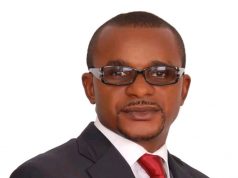
In what has become an annual ritual without results, President Muhammadu Buhari presented budget proposal to the National Assembly. This time, it is N8.6 trillion proposed for spending by Federal Government in 2018 but the question remains how this will translate to better living conditions for the ordinary Nigerian. Senior Deputy Editor, SANYA ADEJOKUN, critically examines the 2018 budget figures.
IN a democracy, the legislature is legally empowered to scrutinise and authorise public finance especially with respect to revenues and expenditures as it passes appropriation bills and transmits same to the executive for assent. Once assented, the document becomes a binding act and any deviation from its faithful application becomes a legal infraction and impeachable.
Budgeting as the principal instrument of fiscal policy used by governments to encourage stable growth, sustainable development, prosperity, and optimum employment in the economy spells out the degree of activities and costs, as well as the specific programmes required for the implementation of the programmes. A budget guides the government on a developmental plan that most times needs to be consolidated to achieve a meaningful aim. Budget implementation is importance because it assesses government performance over time. An effectively implemented budget improves and strengthens the various macro-economic ingredients like poverty, unemployment, inflation, and the financial systems.
To be sure, Section 80 of the 1999 Constitution details the various roles to be played by both the executive and legislative arms of government, there exists some cloudy areas needing judicial interpretation and clarification.
Section 80 of the constitution gave powers over control of public funds to the national assembly.
Section 81 mandates the President to present estimates of the revenue and expenditure of the Federation for the next following financial year.
Section 81 (4) states: If in respect of any financial year it is found that-
(a) The amount appropriated by the Appropriation Act for any purpose is inefficient; or
(b) A need has arisen for expenditure for a purpose for which no amount has been appropriated by the Act, a supplementary estimate showing the sums required shall be laid before each house of the National Assembly and the heads of any such expenditure shall be included in a Supplementary Appropriation Bill.
Clear as this portion of the constitution may seem, there have been a perennial contention about whether in exercising this power of appropriation, the legislature can increase or juggle funds in the estimates submitted by the executive. Some of the pertinent questions to ask here include whether the National Assembly can determine revenue estimates independent of what the executive submits; whether the National Assembly has the capacity or capability to hire consultants outside the influence of the various ministries, departments and agencies who will determine the costs of capital projects to be included in the budget submitted by the executive?
A history of contentions
The true interpretation of Section 81 of the constitution has been rather contentious since 1999. Both the Legislature and Executive appear to take their responsibility in budgeting as absolute thus leading to a battle of supremacy. President Olusegun Obasanjo’s time as president was replete with conflicts with the National Assembly especially over issues of appropriation and budget implementation. At a point, the National Assembly introduced the concept of Constituency Projects into annual budgets independent of what the executive sent to them in the appropriation bill. It was a tug of war at the beginning with Obasanjo insisting that it was wrong for the assemblymen to so alter the estimates he sent to them. This took a long time to resolve but the President eventually gave in.
Although President Umaru Yar’Adua was ill most of his time in government, quarrel over budget preparation, appropriation and implementation did not abate. This was to the extent that on a day that Yar’Adua was billed to travel out for medical treatment, an obviously ill president was forced to address the National Assembly even as the two chambers bickered over which one of them was to host the president.
In 2012, a serious contention over oil price benchmark for the 2013 budget caused deep seated bickering between President Goodluck Jonathan and the National Assembly. Desirous of keeping part of revenue accruing from crude oil sales in the Excess Savings Account, Jonathan proposed a benchmark of $75/barrel but the National Assembly insisted on raising it to $80/barrel. The issue became so contentious that it took the leadership of Peoples Democratic Party (PDP) to resolve the issue.
Earlier on July 20 of the same year, the House of Representatives, threatened to commence impeachment move on President Goodluck Jonathan over what it described as poor implementation of the 2012 budget. The lawmakers also cautioned the Coordinating Minister of the Economy and Minister of Finance, Ngozi Okonjo-Iweala, on the non-release of funds to ministries, departments and agencies of government to implement projects.
The two budgets so far executed by President Muhammadu Buhari have also not gone without controversies.
The president rejected the 2016 budget first for what was described as padding by National Assembly members and again because the amended document sent to him by the legislators was hard to work with. He complained that provisions for major national projects and programmes were either out rightly removed or funds for such slashed. After the budget was scrutinised by the ministers at an emergency meeting it was noticed that some major aspects considered to be government’s core infrastructural focus had been removed. These comprise major projects like the Calabar-Lagos coastal rail line for which Buhari made a provision of N60 billion.
There were also contentions that National Assembly cut the amounts provided for completion of ongoing projects and instead included new roads which studies are yet to be conducted. He said:

The situation was similar in 2017 when Buhari complained that National Assembly had raised the N7.2 trillion Appropriation Bill presented he presented in December 2016 to N7.4 trillion, with the appropriation document predicating sources of funding on oil revenue pegged at N1.985 trillion, non-oil revenue at N1.73 trillion, external and domestic borrowing, and other federal government independent revenue sources.
Highlights of 2018 budget proposal
Transport
- N162.28 billion Counterpart funding for Railway projects including:
- Lagos-Kano (Ongoing)
- Calabar-Lagos (Ongoing)
- Ajaokuta-Itakpe-Aladja (Warri ) (Ongoing)
- Port Harcourt – Maiduguri (New)
- Kano-Katsina-Jibiya-Maradi in Niger Republic (New)
- Abuja-Itakpe and Aladja (Warri)-Warri Port and Refinery including Warri New Harbour (new)
- N2.03 billion Construction of Terminal Building at Enugu Airport
- N8.32 billion Construction of Second Run-Way of Nnamdi Azikwe International Airport Abuja
Power
- N9.8 billion for the Mambilla hydro power project
- N12 billion counterpart funding for earmarked transmission lines and substations
- N10.15 billion for Rural Electrification Access Program in Federal Universities
- N2.8 billion Construction of 215MW LPFO/ Gas Power station Kaduna
- N4 billion Kashimbilla transmission
- N2.56 billion Fast Power Programme Accelerated Gas and Solar Power Generation
Housing
- N35.41 billion Federal Government National Housing Programme
Works
- N10 billion for the 2nd Niger Bridge
- About N295 billion for the construction and rehabilitation of major roads nationwide including:
- Lagos-Shagamu-Ibadan Dual Carriageway,
- Ilorin-Jebba-Mokwa-Bokani Road,
- Abuja-Abaji Road,
- Kano-Maiduguri Road,
- Enugu-Port-Harcourt Dual Carriageway,
- Odupkani-Itu-Ikot Ekpene Road,
- Sokoto-Tambuwal-Jega-Kontagora-Makera Road,
- Dualisation of Obajana Junction to Benin,
- Calabar-Ugep-Kastina Ala Road,
- Onitsha-Enugu Dual Carriageway,
- Abuja-Kaduna-Zaria-Kano Dual Carriageway
- Beni-Ofosu-Ore-Ajebandele-Shagamu Expressway Phase III
Some road projects (cont’d)
- Damaturu-Biu Road In Yobe/Borno States
- Onitsha – Owerri Road And Onitsha Eastern Bypass
- Hadejia-Nguru Road In Jigawa State Phase II
- Otuocha – Anam- Nzam- Innoma-Iheaka- Ibaji Section of Otuocha – Ibaji-Odulu-Ajegwu In Anambra and Kogi states
- Ibadan-Ilorin Section II In Oyo State
- Bodo-Bonny Road With A Bridge Across The Opobo Channel In Rivers State
- Apapa – Oshodi Express Way in Lagos Phase II Sections I & II
- Dualization Of Kano-Katsina Road Phase 1
- Oshogbodo-Oweto Road
- Nasarawa -Loko Road in Nasawara State
- Lambata-Bida Road in Niger State
- Dualisation of Sapele-Ewu Road: Section I: Sapele-Agbor In Delta State
- Dualisation of Suleja-Minna Road Phase Ii
- Dualisation of Yenegwe Road Junction-Kolo-Otuoke-Bayelsa Palm
- Yola-Hong-Mubi Road In Adamawa State
- Abak-Ekparakwa-Ete-Ikot Abasi Road
- Zaria-Pambeguwa (Danbobo) Road In Kaduna State
- 9th Mile-Enugu-Port Harcourt Dual Carriageway In Enugu/Benue states
Health
- N6 billion for Strategic Joint Venture Investments in selected Tertiary Health Institutions with Nigerian Sovereign Investment Authority (NSIA)
- N8.9 billion for procurement of RI vaccines and devices
- N3.5 billion for counterpart funding including global fund, health, and GAVI
- N1 billion for Health Emergencies & Contagious Diseases Outbreaks (e.g meningitis, measles, yellow fever, monkey pox, etc)
- N1 billion for Midwives Service Scheme
- N1.2 billion Polio Eradication Initiative
Water Resources
- N3.5 billion Zobe Water Supply Project – Phase I & II
- N2 billion for Partnership for Expanded Water, Sanitation and Hygiene (PEWASH)
- N1 billion for Special Intervention for North East and IDPs – Portable of Portable Water
- Over N50 billion for water supply, rehabilitation of dams, and irrigation projects nationwide
Agriculture & Rural Development
- N6.75 billion for Rural Roads and Water Sanitation programme
- N25.1 billion for Promotion and Development of Value Chain across 30 different commodities
- N5.30 billion for National Grazing Reserve Development
- N4 billion for Agribusiness and Market Development
- N4.08 billion for Food and Strategic Reserves
- N2 billion for Supply, Installation & Commissioning of Water Rigs Nationwide
- N1.13 billion for FGN Support for Youths in Agribusiness
- N3.22 billion for Livelihood Improvement Family Enterprise (LIFE) Programme
Mines & Steel Development
- N2.1 billion for concessioning of Ajaokuta Steel Company
- N544 million for the establishment of mega regulatory agency for the sector
- N450 million for the reclamation of abandoned mines sites
Industry, Trade & Investment
▪ Special Economic Zone Projects
▪ N46.39 billion for ongoing and planned Special Economic Zone Projects across the geopolitical zones to drive manufacturing / exports.
▪ Completion of Upgrade of Calabar and Kano Free Trade Zones
▪ Completion of Lekki Model Textile and Garment Industrial Park
▪ Completion of feasibility Studies, Master Panning, Engineering Design, EIA and other pre-development Costs in Enugu, Gombe, Nnewi, Kwara, Abuja, Bauchi, Rivers/Bayelsa, Edo/Delta, Taraba/Adamawa, Benue/Plateau, Sokoto/Kebbi
▪ FGN investment in Enyimba Industrial Park, Funtua Cotton Cluster, and Ibom Deep Sea Port and City
▪ Export-Expansion Grant (EEG)
▪ N19.28 billion in the form of tax credits to support export via the Export Expansion Grant
▪ Recapitalisation of Bank of Industry (BOI) and Bank of Agriculture (BOA)
▪ N15 billion provisioned to support these development finance institutions to support Micro, Small and Medium Scale Enterprises (MSMEs)
Education
▪ N5 billion provisioned as Take-off Grant for Maritime University, Delta State
▪ N1.8 billion for Payment of Federal Teachers Scheme Allowance
▪ N566.9 million for Construction of National Library of Nigeria
▪ N7.65 billion for various Scholarship allowances
▪ Niger Delta
▪ N17.42 billion for various sections of the East-West Road
▪ N2.58 billion for Section III from Port-Harcourt Eleme Junction to Onne Port Junction
▪ Regional Interventions
▪ N65 billion for reintegration of transformed ex-militants under the Presidential Amnesty Programme.
▪ N45 billion for Federal Initiative for North-East (Pilot Counterpart funding contribution)
▪ SDGs
▪ N40 billion for SDGs Intervention Programmes
▪ N11.75 billion for other SDGs Projects
▪ Special Intervention Programme
▪ N500 billion for FGN Special Intervention Programme (including Home Grown School Feeding Programme, Government Economic Empowerment Programme, N-Power Job Creation Programme, Conditional Cash Transfers and Social Housing Fund)
According to the National Bureau of Statistics (NBS) about 112 million Nigerians (representing 67.1 per cent) of the country’s total population. NBS also put the total number of Nigerians who became unemployed within the first and second quarter of 2016 at 2.6 million. In its second quarter unemployment and underemployment report the bureau said the country’s unemployment rate grew from 12.1 percent in the first quarter of 2016 to a record high of 13.3 percent in the second. This is up from the about 1.46 million Nigerians that joined the labour market in the third quarter of 2015 in addition to another 518,102 became unemployed in the fourth quarter of 2015. Thus, just between June 2015 and June 2016, total freshly unemployed persons in the economy reached a record high of 4,580,602.
Despite this however, little attention has been paid to faithful implementation of capital component of budgets even by the Buhari administration. In 2016, total capital vote was N1.8 trillion, representing about 30 percent of the entire budget. At the end of the financial year in May 2017 however, only about N1.2 trillion had been released.
And since Prof. Yemi Osinbajo as acting President signed the 2017 budget on June 12, only about N450 billion had been released as at October 31 according to Budget and National Planning Minister, Senator Udo Udoma while making a public breakdown of the 2018 budget estimates on November 14. Total capital expenditure for 2017 is N2.174 trillion. In essence, for the 2017 budget to be faithfully implemented, N543.5 billion has to be released per quarter for capital expenditure (Capex). And when it is considered that there is a current understanding between Buhari and National Assembly to return the country to a budget cycle of January to December, it means by the end of 2017, total Capex released would still have been abysmally low.
High performing revenue profile
Ordinarily, budget implementations are hampered by inadequate revenue. This was the reason adduced by government for the failure of 2016 budget to perform optimally. 2016 was a difficult year for Nigeria because of recession. However, by the confession of Udoma, government’s revenue projections for 2017 has been largely met with both Customs Service and oil projection performing optimally.
He described FGN’s oil revenues and customs revenue as performing almost to target as oil production averaged 1.9mbpd against 2.2mbpd projected. Increased oil prices however, made up for the 300,000 barrels per day shortfall. “Oil revenues amounted to N1.6 trillion vs N1.6 Q3 prorata budget. Collections for CIT and VAT were N407.59 billion and N95.57 billion respectively, implying performance of 67% and 53% respectively of prorata budgets. Customs revenue was N207 billion out of N208.17 billion prorated as at Q3, i.e., 99%; Independent Revenues of N155.14 billion that is 20% has been remitted by government owned enterprises (GOEs)”, he disclosed.
Ambitious and unrealistic fundamentals
Even as Senators prepare to commence debate on the 2018 estimates, there are already signs that much of the underlying fundamentals will be rubbished by lawmakers.
Some of the key assumptions forming the basis of the estimates are crude oil production of 2.3 million barrels per day; crude oil price benchmark of $45 per barrel; exchange rate of N305/US$; inflation rate of 12.42%; nominal consumption of N83.69 trillion; nominal GDP of N113.09 trillion; and GDP growth rate of 3.5%.
Many analysts have described these fundamentals as either unrealistic or ambitious.
In 2017, government predicated the budget on 2.2 million barrels of crude production per day but it was only able to achieve 1.6 million barrels per day around May due to activities of vandals and militants. There is also a current agreement within Organisation of Petroleum Exporting Countries (OPEC) to cut oil production by at least two million barrels per day in order to ramp up prices. The understanding is that once Nigeria attains daily production of 1.9 million barrels per day, it will be subjected to production cuts. It means that the projected 2.3 million barrels per day may eventually not be met.
With a downward adjusted GDP growth projection of 1.5 percent from 2.19, it is difficult to see how the economy will leap to 3.5 percent within one year.
Some members of the National Assembly have also expressed determination to abolish the Excess Crude Oil Account (ECA), which they described as unconstitutional. Nineteen Senators jointly sponsored a motion calling on the executive to pay the amount above the oil benchmark into the Federation Account in compliance with the constitution. Lead sponsor, Sen. Rose Oko (PDP-Cross River) expressed regret that the ECA was not in tandem with Sections 80(1-4) and 162(1-3) of the 1999 Constitution. There are two serious implications to this decision: lawmakers may significantly raise budget benchmark from $45/barrel to between $55 and $60 considering that oil has stayed above $60 for some time now and tensions in the Middle East suggest continuous upward rather than downward movement; the other implication is that the N2.005 trillion inherent deficits in the budget proposal will then be drastically reduced. These two scenarios will greatly alter the face of the final outcome.
Some economic and financial experts have equally queried the sense behind pegging exchange rate at N305 per US dollar when market rate has hovered around N360/$ in the last many months. Adjusting this to realistic market rate will also reduce deficit tremendously.
Legislators however, have a penchant to then introduce new projects rather than reduce the deficits, which will in turn lead to the next round of squabbles with the executive.





